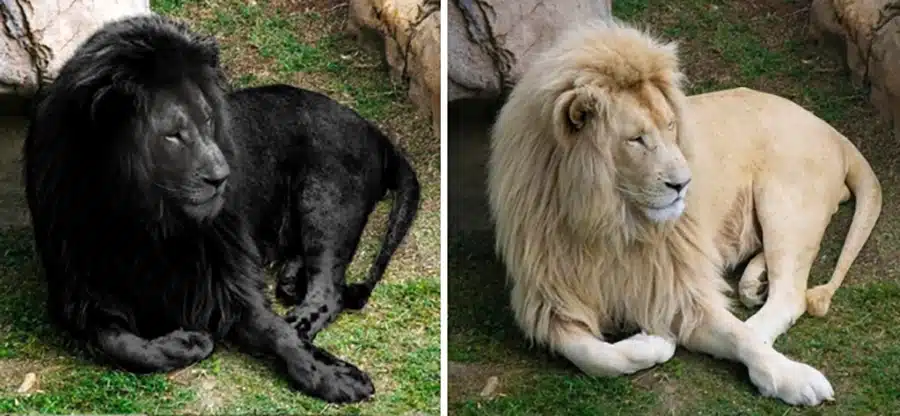The existence of a black lion has captured the imagination of many people for years. Photos and stories about these striking animals have circulated widely on social media platforms like Facebook and Twitter, often sparking debate and wonder. Despite the compelling nature of the images that appear in these online discussions, biologists and wildlife experts insist that that black lions are not, in fact, real.
A lion appearing completely black would be the result of to melanism, a genetic condition that results in an increased amount of black pigment in the skin and fur. While common in big cats, such a case has never been documented in lions.
The allure of discovering or capturing images of a black lion has led to numerous digitally altered photos on platforms like Flickr and DeviantArt, where artists often share their creative takes on various subjects, including wildlife. These artistic renditions, while impressive, contribute to the myth of the black lion’s existence.
Melanism in Big Cats
Melanism occurs as a result of a genetic condition leading to an excess production of melanin, the pigment responsible for dark coloration in animals. This trait can manifest in various species, including big cats such as jaguars and leopards. Melanistic individuals often display a much darker, sometimes completely black coat.
In jaguars, melanism is due to a dominant allele, and it is relatively common. A melanistic jaguar is therefore not an entirely separate species, but rather a normal jaguar that expresses this particular genetic trait. Similarly, leopards can carry a melanistic gene which triggers the darkening of the fur. While melanistic leopards are less common than their non-melanistic counterparts, certain geographic areas do exhibit a higher presence of this phenotype.
Genetics play a central role in the development of melanism. It is important to note that while the term black panther is used broadly, it does not pertain to a specific species, but rather describes melanistic individuals of either leopards or jaguars.
Scientists have explored the potential adaptive advantages of melanism, suggesting that it could offer some benefits (such as camouflage) under specific ecological conditions. However, the exact reasons and mechanisms driving the prevalence of melanism in big cat populations continue to be studied by scientists.
The Myth of the Black Lion
Black lions – myth or rare phenomenon?
The existence of black lions has long intrigued people, prompting a blend of both mythology and misleading imagery that has permeated online platforms and popular culture, despite a clear lack of authentic scientific evidence supporting the existence of such creatures.
The black lion does not exist in the wild or in captivity as a natural occurrence or otherwise. Scientists, including award-winning biologist Gerard Ceballos, have explicitly stated that black lions have never existed. The idea of a black lion is a myth, not a rare biological phenomenon.
The natural world is full of wonders and genuine mysteries, but the black lion remains a creature of legend, not of the living, breathing savannas or jungles of our planet.
Photoshopped Images Online
Numerous images of supposed black lions have circulated online, leading some to believe they are real. These images are usually standard stock images that have been digitally manipulated to give the lion’s coat a black hue, a clear example of how technology can create compelling but untrue visuals.
These depictions are typically created through digital alterations and are not representative of any living species of lion.

Popular Culture and Misconceptions
In popular culture, the concept of mythical creatures like the black lion appeals to the imagination and has been used in various fictional contexts. Due to their striking appearance in such media, misconceptions have arisen, further fueled by the proliferation of such images on the internet. However, there is no zoological basis for the existence of black lions, with their lore being just that—a combination of myth and digital artistry.
Unusual Lion Color Variants That Actually Exist
As disappointing as it is that black lions never actually roamed the African savanna, there are actual lion color variants that do exist.
The most visually striking among those is the white lion, which occurs naturally in South Africa, where white lions have been sighted in the Greater Timbavati and southern Kruger Park regions. These unusually white lions result from a genetic mutation called leucism, which causes partial loss of pigmentation (not to be confused with albinism).
Frequently Asked Questions
Are black lions real?
Contrary to popular myths, black lions do not exist. Scientists and biologists, like Gerard Ceballos, have confirmed that these creatures are a myth. Images or claims suggesting the presence of black lions are often found to be doctored or misrepresented.
Are there any lion species known to have completely black fur?
There are no lion species that possess completely black fur. While there is a phenomenon known as melanism that causes an increased presence of dark pigmentation in the skin or fur of animals, lions are not known to be affected by this condition in a way that would result in completely black fur.
How does melanism affect lions, and are there any documented cases?
Melanism, responsible for dark pigmentation in certain animals, has not been observed to cause completely black fur in lions. Instead, lions can have darker manes, which are sometimes misconstrued as an indication of melanism. However, actual cases of black-maned lions exist, which are nevertheless not an instance of true melanism affecting the entirety of their fur.
